You’re about to discover how to transform your living space into a lush oasis that combines style with nature’s beauty. From creating dramatic living walls that span 6-8 feet high to arranging compact 2-tier window displays with sun-loving succulents, these seven plant-focused design strategies will maximize your space’s potential. Whether you have a sprawling living room or a cozy studio apartment, each technique adapts to your specific layout while improving air quality and aesthetic appeal.
Contents
Create a Living Wall With Vertical Gardens
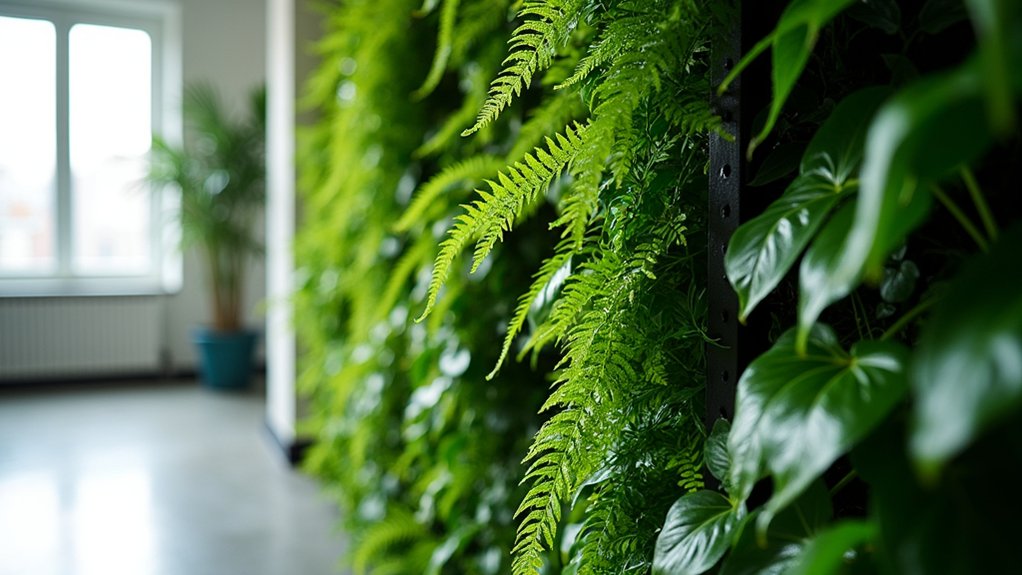
Living walls, also known as vertical gardens, transform ordinary walls into lush, vibrant tapestries of greenery by arranging plants in a vertical orientation. These installations can range from simple hanging pocket systems to elaborate hydroponic setups, featuring a diverse mix of foliage plants, succulents, herbs, or flowering species arranged in geometric patterns or natural-looking configurations.
Vertical gardens maximize space in both indoor and outdoor settings while providing aesthetic appeal and improving air quality.
Growing Conditions:
- Light: Moderate to bright indirect light; avoid direct sunlight for indoor walls
- Humidity: 40-60% relative humidity
- Temperature: 65-80°F (18-27°C)
- Irrigation: Automated drip system or regular manual watering
- Growing Medium: Lightweight, well-draining potting mix or hydroponic substrate
- Air Circulation: Good airflow to prevent mold and fungal issues
- Support Structure: Strong mounting system rated for the weight when fully saturated
Regular maintenance is essential for a thriving living wall, including monthly pruning to control growth and maintain design integrity, checking irrigation systems for clogs or leaks, monitoring plant health for signs of pest infestation or disease, and replacing any declining plants promptly.
Fertilization should be carried out every 4-6 weeks during growing season using a balanced, water-soluble fertilizer, while periodic cleaning of leaves helps maintain appearance and ensures proper photosynthesis.
Design a Window-Side Plant Sanctuary
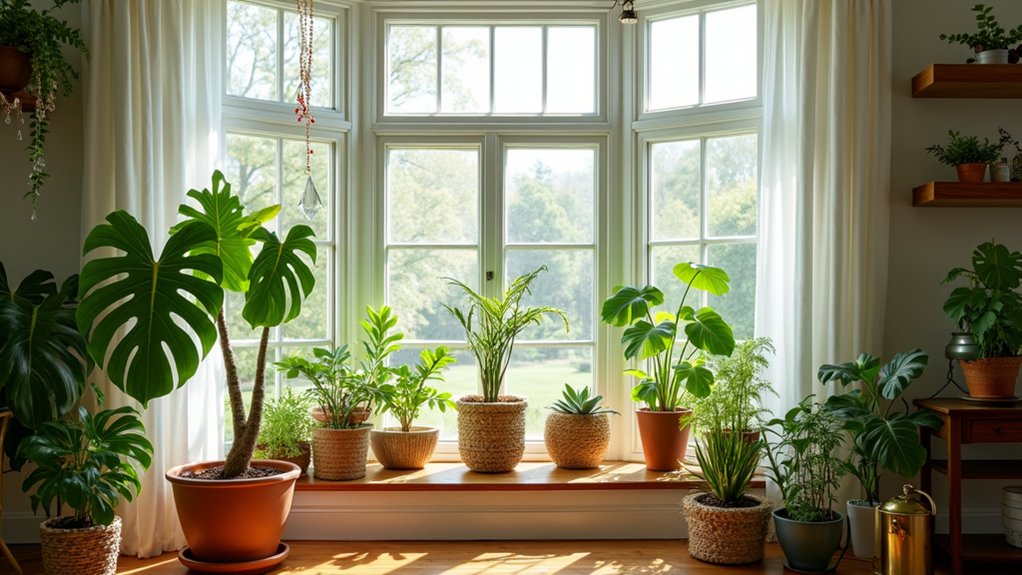
A window-side plant sanctuary transforms an ordinary window space into a lush, living display that maximizes natural light and creates a seamless connection between indoor and outdoor environments. This arrangement typically features a collection of plants at varying heights, utilizing window sills, hanging planters, tiered stands, or floating shelves to create a dynamic vertical garden.
The sanctuary can incorporate both sun-loving and shade-tolerant species, arranged based on their light requirements, with taller plants positioned strategically to avoid blocking light from smaller specimens.
Growing Conditions:
- Position plants within 3-6 feet of windows for optimal light exposure
- East or west-facing windows are ideal for most indoor plants
- Maintain humidity levels between 40-60% using pebble trays or humidifiers
- Room temperature should stay between 65-80°F (18-27°C)
- Use well-draining potting soil appropriate for each plant species
- Ensure proper air circulation without cold drafts from windows
Regular maintenance of a window-side plant sanctuary involves rotating plants quarterly to ensure even growth, dusting leaves monthly to maximize light absorption, and adjusting plant positions seasonally as light patterns change.
During winter months, move sensitive plants a few inches back from cold window panes to protect from temperature fluctuations, and consider adding supplemental grow lights for darker days.
Monitor for signs of light stress, such as leaf scorching or pale growth, and adjust plant placement accordingly.
Style Open Shelving With Cascading Plants
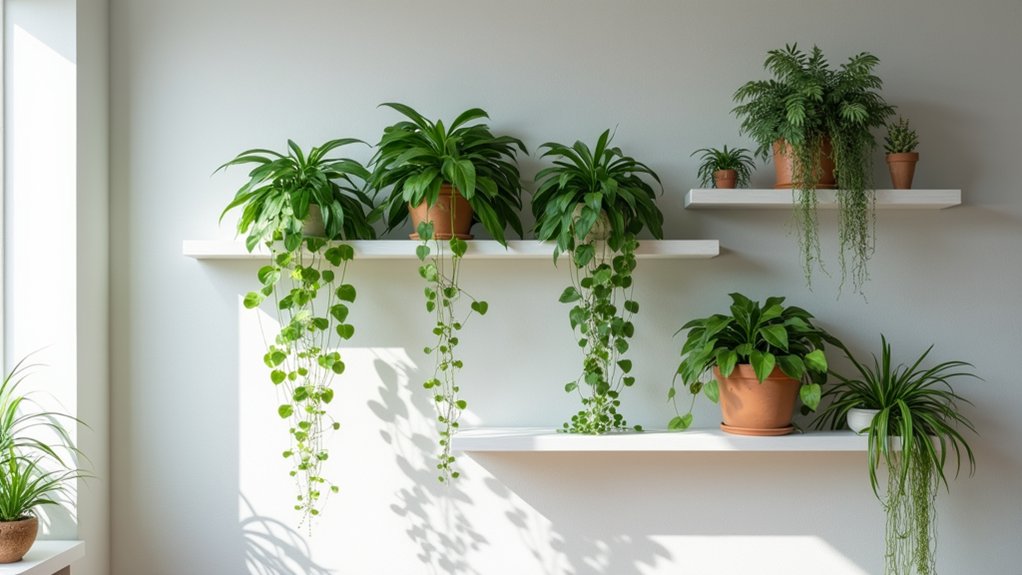
Styling open shelving with cascading plants creates a stunning visual display where trailing vines and foliage gracefully spill over shelf edges, adding natural movement and depth to your space. Popular cascading plants like Pothos, String of Pearls, or Spider Plants transform ordinary shelving units into living green installations, softening hard architectural lines while maximizing vertical growing space.
The layered effect of different plant lengths creates dimension and interest, particularly effective when mixing varieties with varying leaf shapes, sizes, and shades of green.
Growing Conditions:
- Bright to moderate indirect light, avoiding harsh direct sunlight
- Well-draining potting soil with added perlite for improved aeration
- Water when top 1-2 inches of soil feels dry
- Moderate humidity levels (40-60%)
- Temperature range of 65-80°F (18-27°C)
- Containers must have drainage holes
- Monthly feeding with balanced liquid fertilizer during growing season
Regular pruning helps maintain attractive cascading shapes and prevents plants from becoming too leggy or tangled. Rotate pots quarterly to ensure even growth, and dust leaves monthly to maintain their ability to photosynthesize effectively.
When positioning plants, consider their mature trailing length and ensure adequate space between specimens to prevent overcrowding. Remove any yellowed or damaged foliage promptly to maintain aesthetic appeal and plant health.
Arrange Botanical Centerpieces for Tables
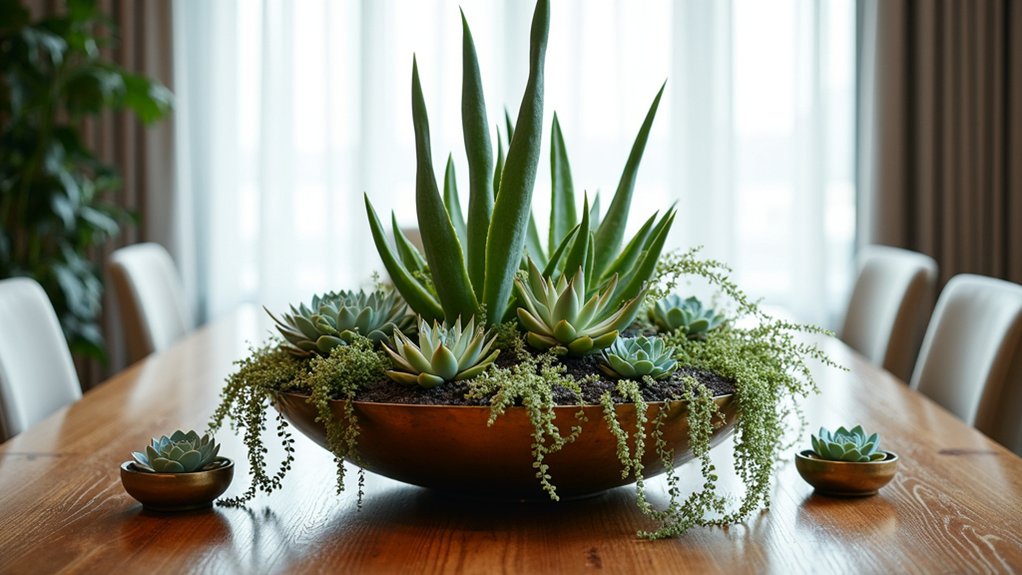
Creating botanical centerpieces for tables transforms ordinary dining spaces into vibrant focal points that bring nature indoors. These arrangements typically combine different plant heights, textures, and colors, using elements like succulents, air plants, small potted herbs, or flowering plants grouped in decorative containers. Centerpieces can be designed as single dramatic arrangements or as a collection of smaller coordinated pieces running along the table’s length.
- Light: Position centerpieces in areas receiving medium to bright indirect light, avoiding direct sunlight that can damage delicate flowers or leaves.
- Water: Use containers with drainage holes or add pebbles at the bottom for excess water.
- Soil: Choose well-draining potting mix appropriate for each plant type.
- Temperature: Maintain room temperature between 65-75°F (18-24°C).
- Humidity: Group plants together to create beneficial moisture levels.
- Container: Select vessels that complement room decor and are proportionate to table size.
To maintain beautiful table centerpieces, rotate plants weekly for even growth and to prevent them from leaning toward light sources. Remove any yellowing leaves or spent blooms promptly to maintain aesthetics and prevent disease spread.
Consider selecting plants with similar care requirements when grouping them together, and keep arrangements scaled appropriately to allow comfortable conversation across the table. Dust leaves regularly with a soft cloth to maintain their natural shine and ensure proper photosynthesis.
Build a Modern Plant Corner Display
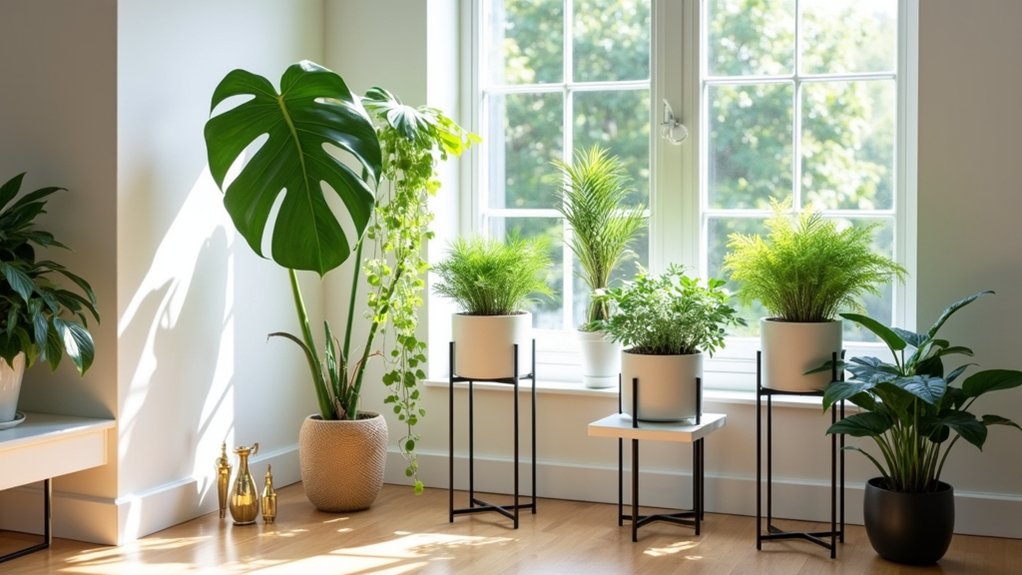
A modern plant corner display transforms an empty corner into a striking architectural feature using carefully arranged plants at varying heights and depths. This contemporary approach typically combines sleek metal or geometric stands, floating shelves, and minimalist planters in neutral tones to create visual interest.
Plants are arranged in a deliberate asymmetrical pattern, mixing trailing varieties with upright specimens and incorporating different leaf shapes and textures while maintaining a cohesive color palette.
- Bright to moderate indirect light, avoiding harsh afternoon sun
- Humidity levels between 40-60% for tropical varieties
- Well-draining potting mix appropriate for each plant type
- Temperature range of 65-80°F (18-27°C)
- Space between plants to allow proper air circulation
- Stable location away from drafts and heating/cooling vents
Regular maintenance ensures the display remains polished and professional. Rotate plants quarterly to promote even growth, and clean leaves monthly to remove dust and maintain their glossy appearance.
Prune any yellowing or dead foliage immediately to preserve the clean aesthetic, and rearrange plants periodically as they grow to maintain balanced proportions.
Consider incorporating a small humidifier or pebble tray if the air is dry, and group plants with similar care requirements together for easier maintenance.
Transform Your Bathroom Into a Tropical Oasis
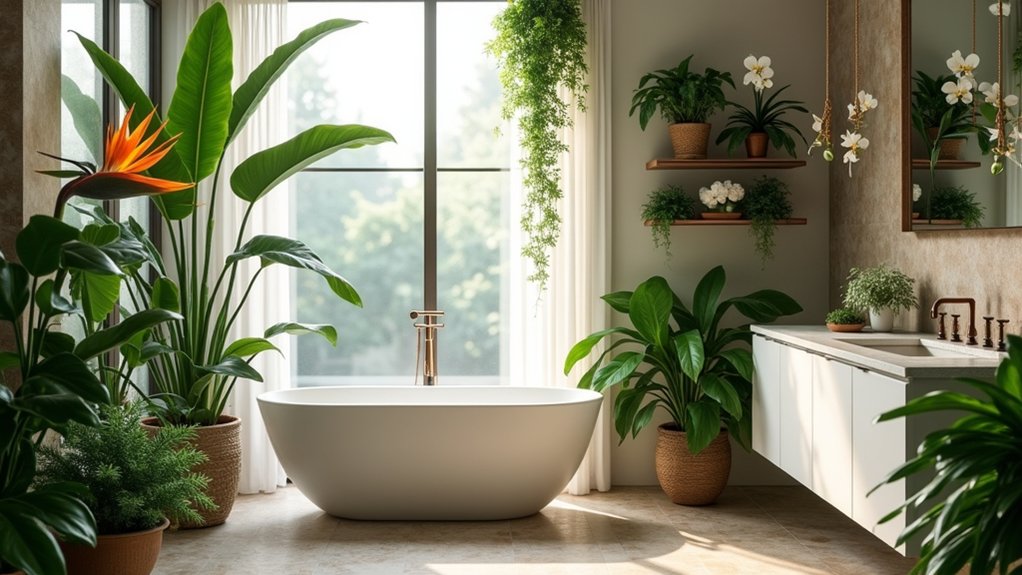
Transform your bathroom into a lush tropical sanctuary by incorporating moisture-loving plants that thrive in humid environments. The combination of ferns, orchids, peace lilies, and hanging pothos creates a spa-like atmosphere while naturally purifying the air.
Strategic placement of plants on windowsills, countertops, and shower caddies adds layers of verdant texture, while larger floor plants like bird of paradise can serve as dramatic focal points in spacious bathrooms.
Growing Conditions:
- Humidity levels between 60-80%
- Indirect to bright filtered light, avoiding direct sunlight
- Well-draining potting mix with added perlite
- Temperature range of 65-80°F (18-27°C)
- Regular misting for plants not directly exposed to shower steam
- Container with drainage holes to prevent root rot
Regular maintenance is essential to keep your bathroom jungle thriving. Rotate plants quarterly to ensure even growth and prevent stretching toward light sources.
Dust leaves monthly with a damp cloth to maintain their ability to photosynthesize effectively and remove any mineral deposits from hard water spray.
Watch for signs of mold or mildew on soil surfaces, and improve air circulation with a small fan if needed. Trim yellowing or dead foliage promptly to maintain aesthetics and prevent fungal issues.
Incorporate Hanging Plants in Empty Corners
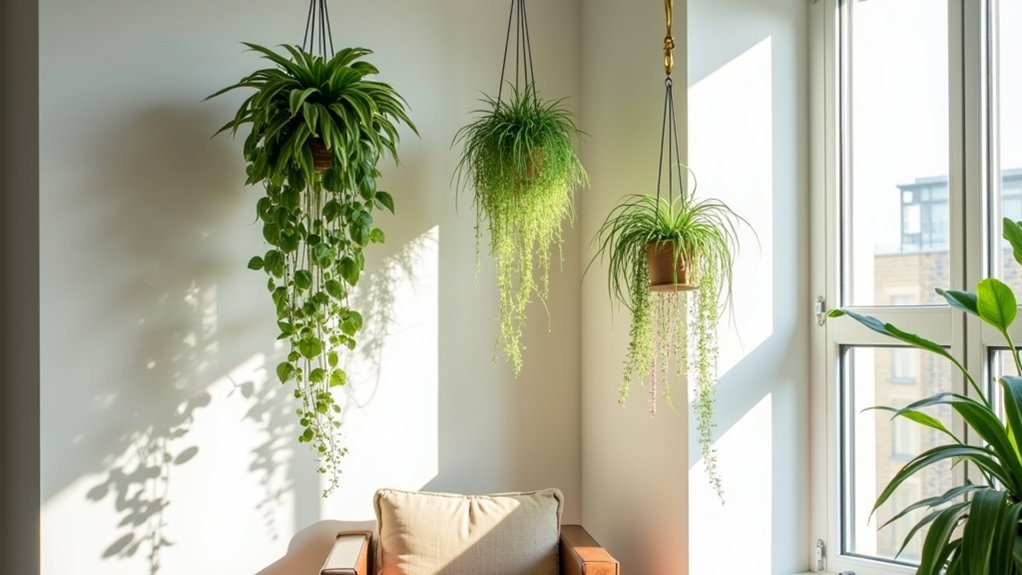
Hanging plants can transform empty corners into vibrant, dynamic spaces while maximizing vertical real estate in any room. Suspended from ceiling hooks or wall-mounted brackets, cascading plants like pothos, spider plants, or string of pearls create visual interest and soften architectural lines with their trailing foliage.
These living curtains of greenery add depth and dimension to otherwise unused corners, while naturally drawing the eye upward to create the illusion of higher ceilings.
- Light: Most hanging plants prefer bright, indirect sunlight; avoid direct sun which can scorch leaves
- Water: Allow top 1-2 inches of soil to dry between waterings
- Soil: Well-draining potting mix with added perlite or orchid bark
- Temperature: Maintain 65-80°F (18-27°C)
- Humidity: Moderate to high; mist leaves regularly in dry conditions
- Container: Use lightweight pots with drainage holes
- Support: Secure mounting hardware rated for pot weight when fully watered
Regular grooming and rotation are essential for maintaining attractive hanging plants in corners. Trim yellowed or dead foliage promptly, and rotate pots quarter-turn weekly to ensure even growth on all sides.
Check mounting hardware monthly for security, and consider installing a pulley system for easier watering access with high-mounted plants. During growing season, fertilize with balanced liquid fertilizer monthly, and repot every 2-3 years or when roots become visible through drainage holes.
